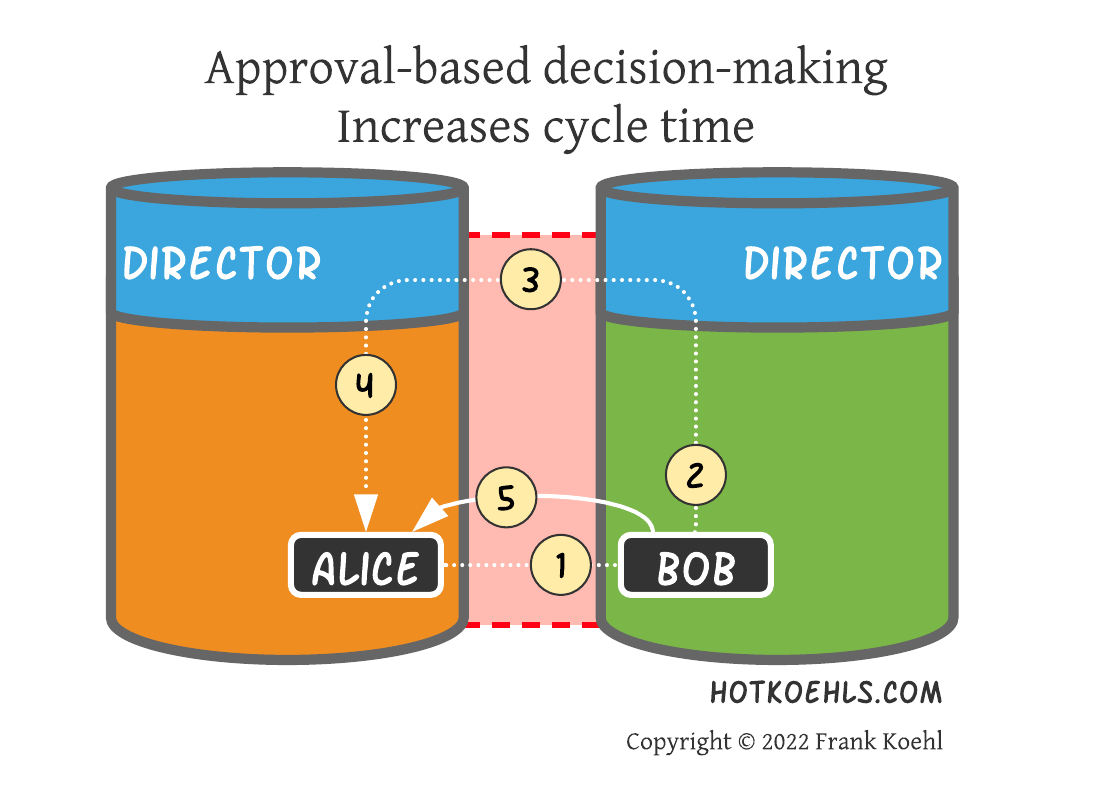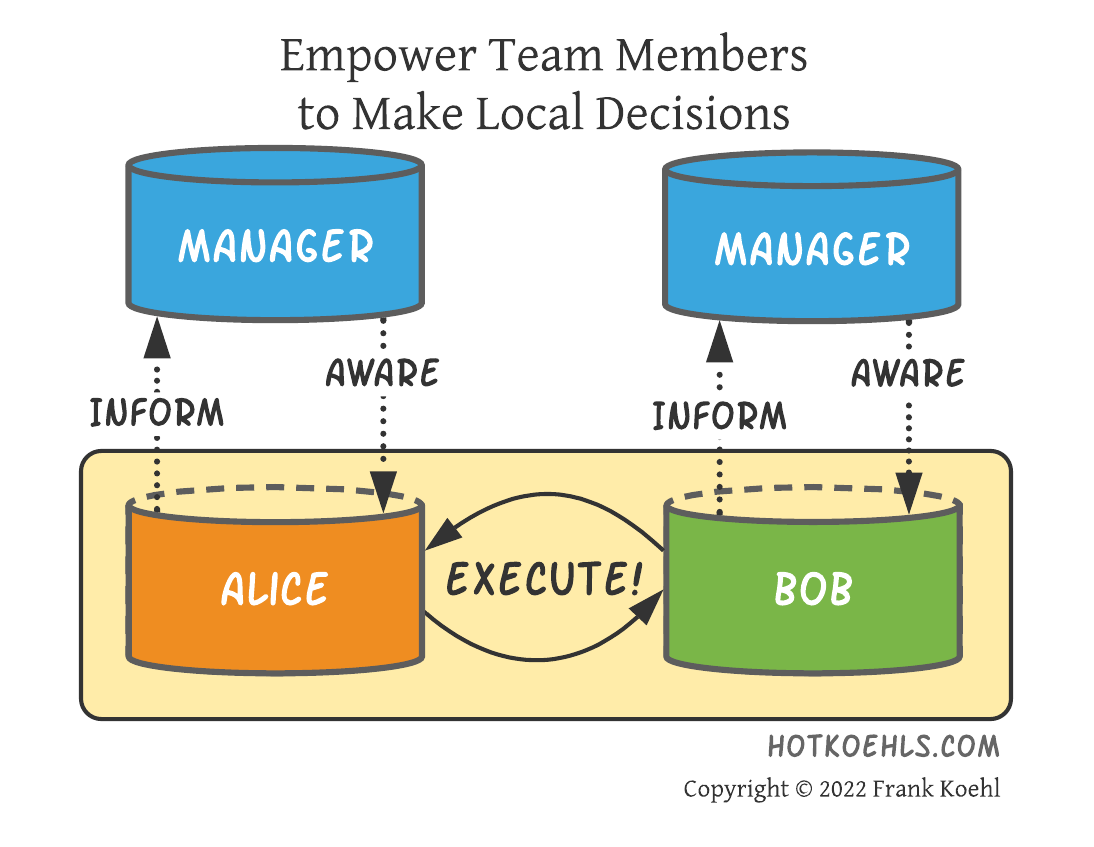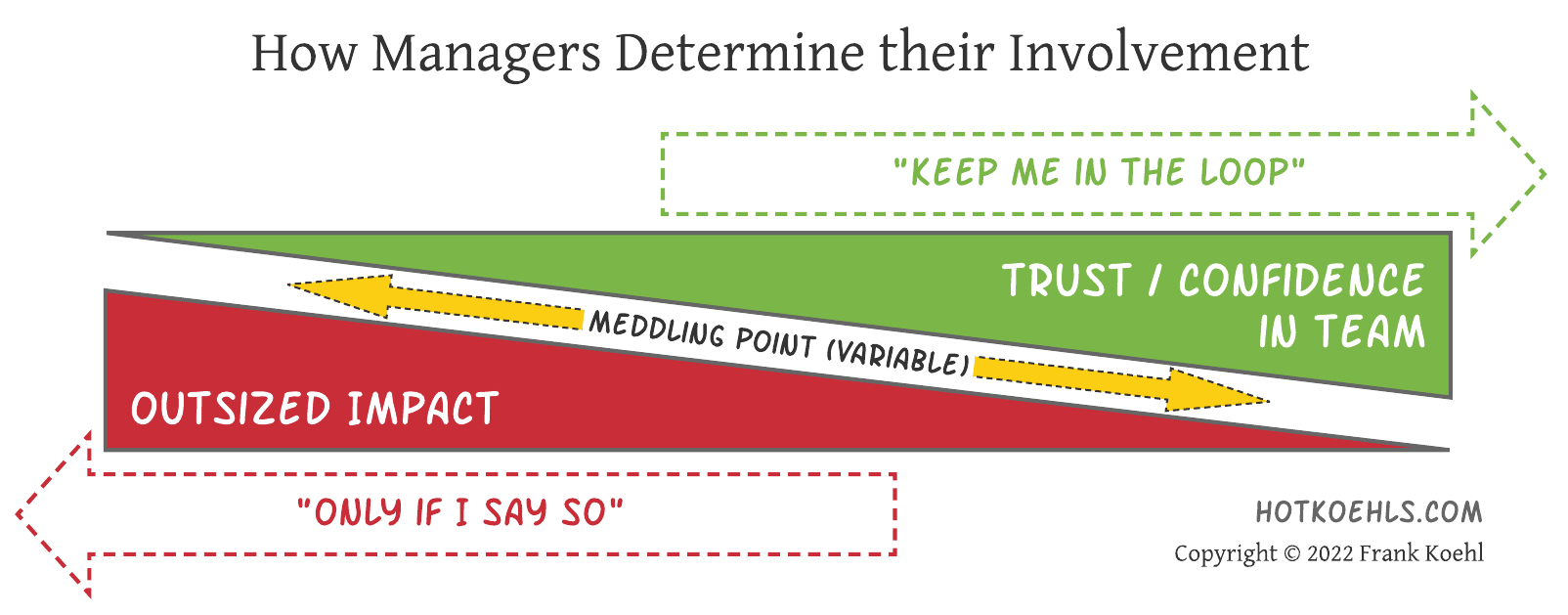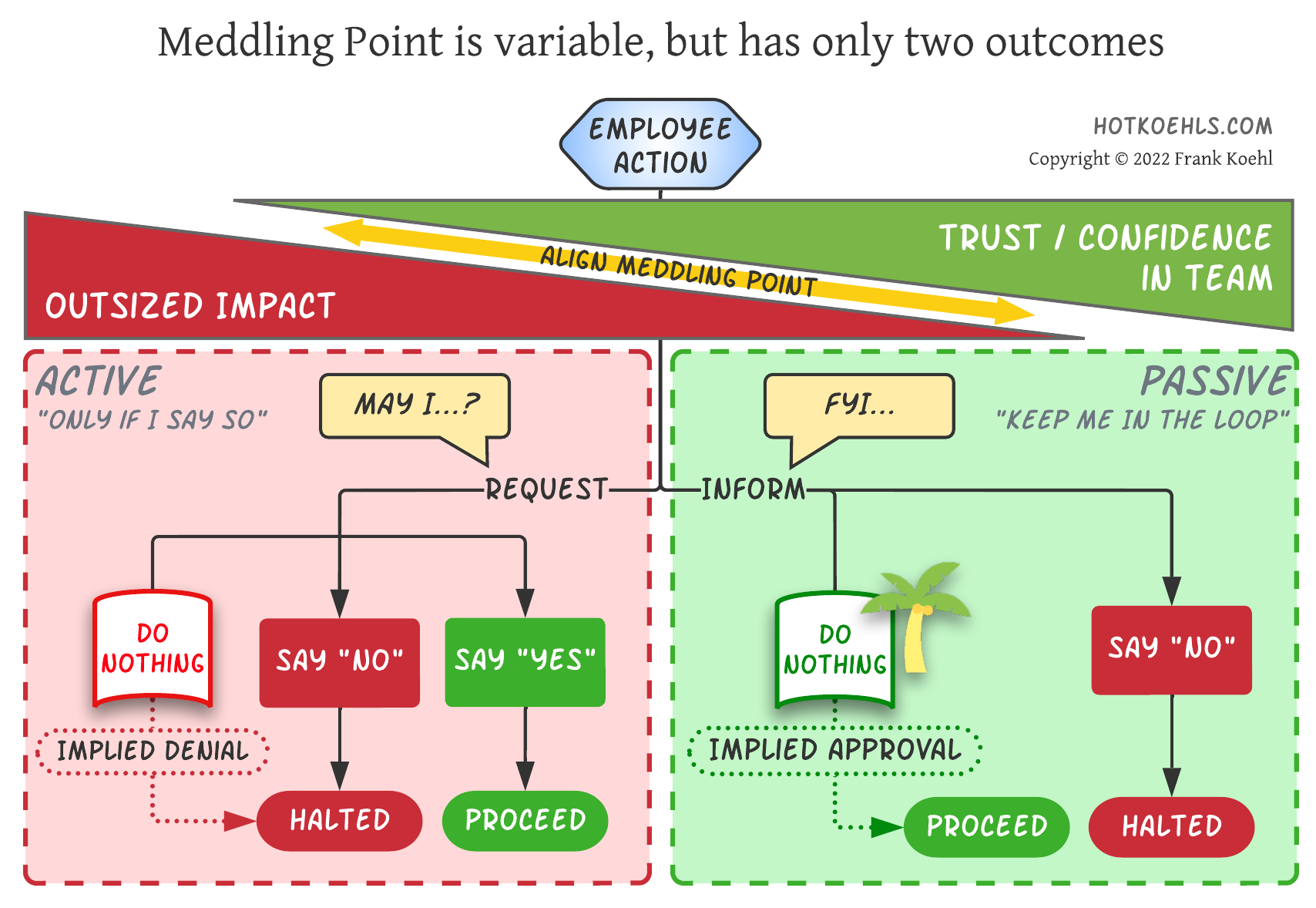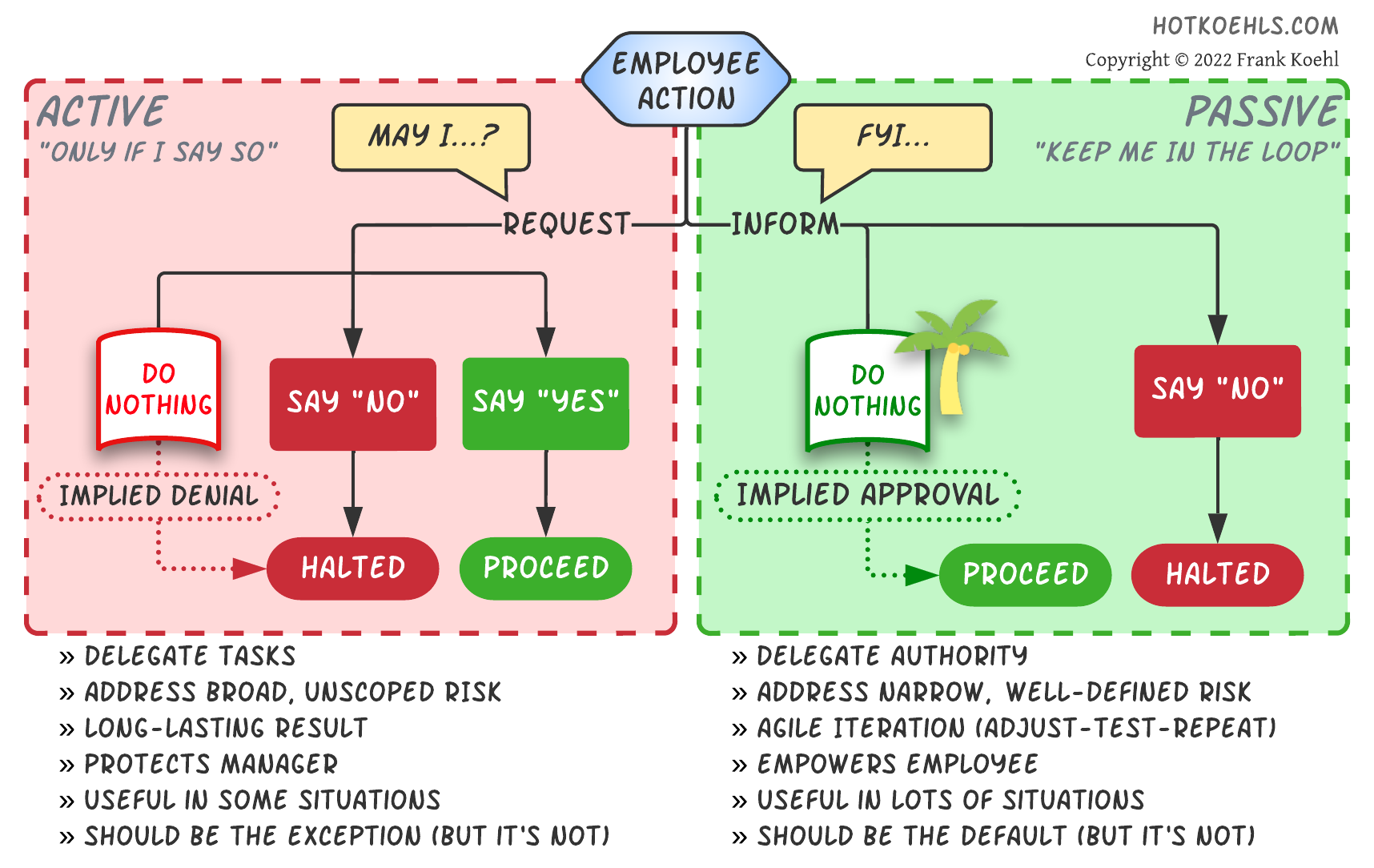Adjust Your Meddling Point - A Case for Managing Less

We've all dealt with this kind of leadership, don't emulate it.
In a previous article about crappy silos, I shared a common loop that happens whenever someone needs help outside their immediate team.
On the one hand, I made the point that Alice and Bob are “grown ass adults” (TM) fully capable of making decisions. After all, the company wouldn’t have hired them if they weren’t capable, right?
However the manager has a legitimate role to play as well: make sure the work is aligned with company objectives. Those objectives can change, sometimes in radical and unexpected ways. Contrary to pop culture belief, the vast majority of managers are not power-hungry, ego-maniacal jerks. Managers implement reviews and approvals in order to eliminate the risk that Alice and Bob might waste time on something that’s not worthwhile, making everyone look bad.
Then we showed this graphic, outlining how Alice and Bob could and should work, without heavy-handed oversight.
Let’s focus on those “Inform” and “Aware” arrows going to/from the manager. The implication is pretty simple: Alice and Bob keep their bosses informed about what they’re doing, allowing the managers to maintain awareness and provide guidance or adjustment as needed. This works great for Alice and Bob, but why would the managers willingly sign up for this?
Let’s assume Alice’s manager is named Mandy. At a glance, Mandy may consider this approach shortsighted, “Just trust Alice to do the job? Why am I here? Sounds like I assume a lot of risk with little-to-no upside. If something goes wrong, I’ll have MY boss breathing down my neck asking why I let it happen…”
She’s not wrong, but she’s only looking at half the picture. So, where’s the upside for Mandy, and the company more broadly?
Define: Meddling Point
Any time an employee takes action, a decision is being made. In order to make sure she focuses on the most important things, Mandy has a mental threshold of importance. She wants to stay directly engaged in all matters that meet or exceed this threshold. I call this threshold the Meddling Point.
Yes, the name is a little tongue-in-cheek, there are all manner of good reasons for Mandy to be directly involved that we wouldn’t consider meddling.
The Meddling Point is malleable, it will be a little different for each employee and project. It’s affected by externalities, like the company’s product focus, client engagement, executive influence, and her own self interest (that’s not a knock on Mandy, we all look out for ourselves).
Setting a Meddling Point is not only fine, but necessary: actions that have a bigger impact, or affect more people, should go through more thorough vetting processes. The problem, as with so many things, is determining when we overstep beyond fruitful engagement to the point of being meddlesome (hence the name “meddling point”).
We can observe good use of Meddling Points in programming all the time when code goes through multiple gates before hitting production: linters, unit tests, integration tests, code review, client acceptance, etc.
We also see poor Meddling Points in programming, such as when security teams open tickets for “vulnerabilities” discovered in code that is under heavy active development. That’s not helping, that’s creating more work for everyone, and more noise that can distract from the actually important indicators.
Herein lies the crux of the problem: for many companies and managers, the Meddling Point becomes rigid and fixed, applying the same constraints and requirements on every scenario. Our earlier example of overeager security incident response is indicative of an inflexible Meddling Point. Here are a few other common examples:
- A $74 personal office expense requires the same executive approval as a $3000 equipment purchase.
- Daily stand up calls run for an hour or more due to team lead’s desire to cover all outstanding tasks, regardless of priority.
- A Sales Rep brings in help from Engineering to drive a sale, then offers little-to-no support to the customer or the engineer after making the introduction.
Note the difference between the first two examples and the last one. We naturally think of Meddling Points being set too “high” (excessive interference), but it’s just as possible for it to be set too “low” (excessive distance).
Why does this happen? Humans are naturally habit-forming; we use repeated behaviors to simplify the wide array of complexity we face every day. It is therefore easy to rely on habits that have kept us in good stead in the past, even when they don’t fit well with the present situation.
Fortunately, the problem also provides a solution! We can avoid letting good habits go bad by getting into a separate habit of reassessing ourselves. As managers, in order to manage our meddling, we must take time to ensure our Meddling Point is calibrated for any given situation.
Meddling Point within Team Dynamics
Reflecting on your Meddling Point is only a worthy effort if you can put the decision into action. While the Meddling Point lives on an analog scale, the ultimate outcome is inversely a binary choice: either you defer decision-making to the team/employee, or you don’t. This choice has radical effects on everyone involved.
To explain, let’s expand our Meddling Point sliding scale to include the binary outcomes.
Once the manager has determined where the impact of an action lands in comparison to their trust/confidence in the execution, their oversight will take one of two forms:
Active Management, Implied Denial
- Manager retains involved, active role in daily work.
- Decision power retained by the Manager, until and unless explicitly delegated.
- All decision-making is a proactive request-response loop.
- Doing nothing prohibits activity, a Manager’s non-response implies denial to act.
Passive Management, Implied Approval
- Manager focuses on oversight of the assigned work.
- Manager delegates decision-making agency and authority to team/employee executing the work.
- A regular communication loop is required to keep the Manager informed, but it occurs asynchronously from the team’s internal decisions and action.
- The manager must step in to actively block or redirect a decision, on an exception basis.
Some additional observations that jump out upon further study…
- Active management requires proactive effort from everyone, all the time. Manager must approve/deny, employee must ask. If the initial request goes unanswered, employees must ask repeatedly.
- Two of the Active paths lead to a “no” response, raising the likelihood that a majority of interactions on the Active path will lead to a negative outcome, which is a deflating experience for the employee. Managers can still say “yes” more than “no,” but the odds are against it.
- With three paths on left, versus two on the right, Active Management is a heavier mental burden. The employee must weigh the chances of success vs the effort required, and the manager tracks decisions across four states (new, do nothing, say no, say yes) . Compare with Passive Management, where all information is delivered as a matter-of-course via routine updates (“keep me in the loop”), eliminating this mental cycle entirely.
- Passive Management actively encourages routine updates, e.g. weekly 1-on-1 meetings. The employee is incentivized to bring information to the table promptly: “f I keep Mandy informed, I can stay focused on the work.” Manager’s load is reduced to information ingestion, allowing them to naturally focus on what matters most, namely employee performance, effectiveness, and well-being.
Consider the Outcome
In order to pick the right path, we assess the potential outcomes, good and bad. The proper path will encourage good results, and discourage bad ones. Outcome consideration ultimately breaks down into four dimensions.
1. Risk
When the risks surrounding the project are unknown, unmitigated, or overly large, Managers will naturally and rightly want to stay directly involved, enabling them to see and head off the risk as it creeps up. This is arguably the defining element of effective management, which is why it’s listed first.
Here’s a few examples where the risk profile would naturally push Mandy to actively management a situation.
- Unknown Risk New feature being developed on minimal customer feedback with a nebulous roadmap. Feature could be a great success, complete dud, or something between.
- Unmitigated Risk New initiative taken on behalf of the company’s largest client. Bad results will negatively affect the relationship and ongoing business arrangements.
- Outsized Risk Team is performing a major one-way release, with no effective path to rollback if something goes wrong. Any problems experienced in production will have to be handled directly, in real time.
2. Permanence/Durability
The time, money, and effort it would take to change course on the decisions made in a project collectively define the permanence of that project. Highly permanent decisions call for Active Management, and should have routine checks to ensure things are moving in the right direction. In contrast, decisions and outcomes that can be correctly in short order, with minimal effort, would be less permanent. Agile ideology in software development is intended to address this problem.
Note: It could be argued that our definition of “permanence” here is synonymous with “risk”, and should be handled in similar fashion.
3. Personal Affect
This is the wild card, where the manager’s personal confidence and security put their thumb on the scale. The task at hand could be minimal, but have major consequences for manager. For example, the first major project in a new role, or the first project after receiving a reprimand would get special attention, no matter how insignificant the work might be. These are good reasons to let personal interest sway a decision.
However poor managers, lacking confidence in themselves or their position, will use personal affect as a crutch to justify their existence, inserting themselves where it’s unnecessary, even detrimental. When the Meddling Point is too high, and manager involvement is excessive or overbearing, this is the place you look first.
All things being equal, tie goes to the employee. Let them own decision and the results, and they’ll work twice as hard to ensure success.
4. Default Posture
Both paths have their valid uses, but the red/green color scheme was a deliberate choice. All things being equal, Passive Management and Implied Approval makes everyone’s life easier. Team members recognize the trust and faith you put in their skill. They feel empowered, which increases their work output and their job satisfaction at the same time. Yes, you get greater productivity, and make them happier doing so, all while taking on less direct work yourself.
I also find that most of the times I chose to walk the Implied Denial path, the reason stemmed from my own insecurity (or the insecurity of an executive), as opposed to some true externality. Humans are exceptional at risk management, which means we usually see and focus on the potential downside. Problems in the rearview are almost never as bad as they first appear. Unless you can point to a categorically unmovable external risk, push past your fears and trust the team you have built.
Here’s a summary breakdown of the two paths…
No Decision Final
The biggest problem with Active Management and Implied Denial thinking is the natural tendency to let it persist in perpetuity. We favor maintaining the status quo, over adjusting our posture based on changing circumstance. When all you have is a hammer, everything looks like a nail.
The manager should re-assess their Meddling Point at every decision point, regardless of size/importance. Just because the entire project is super-important does not mean the manager must be involved at every step. Break the process down in multiple smaller loops and decision points, and use the right process at the right time.
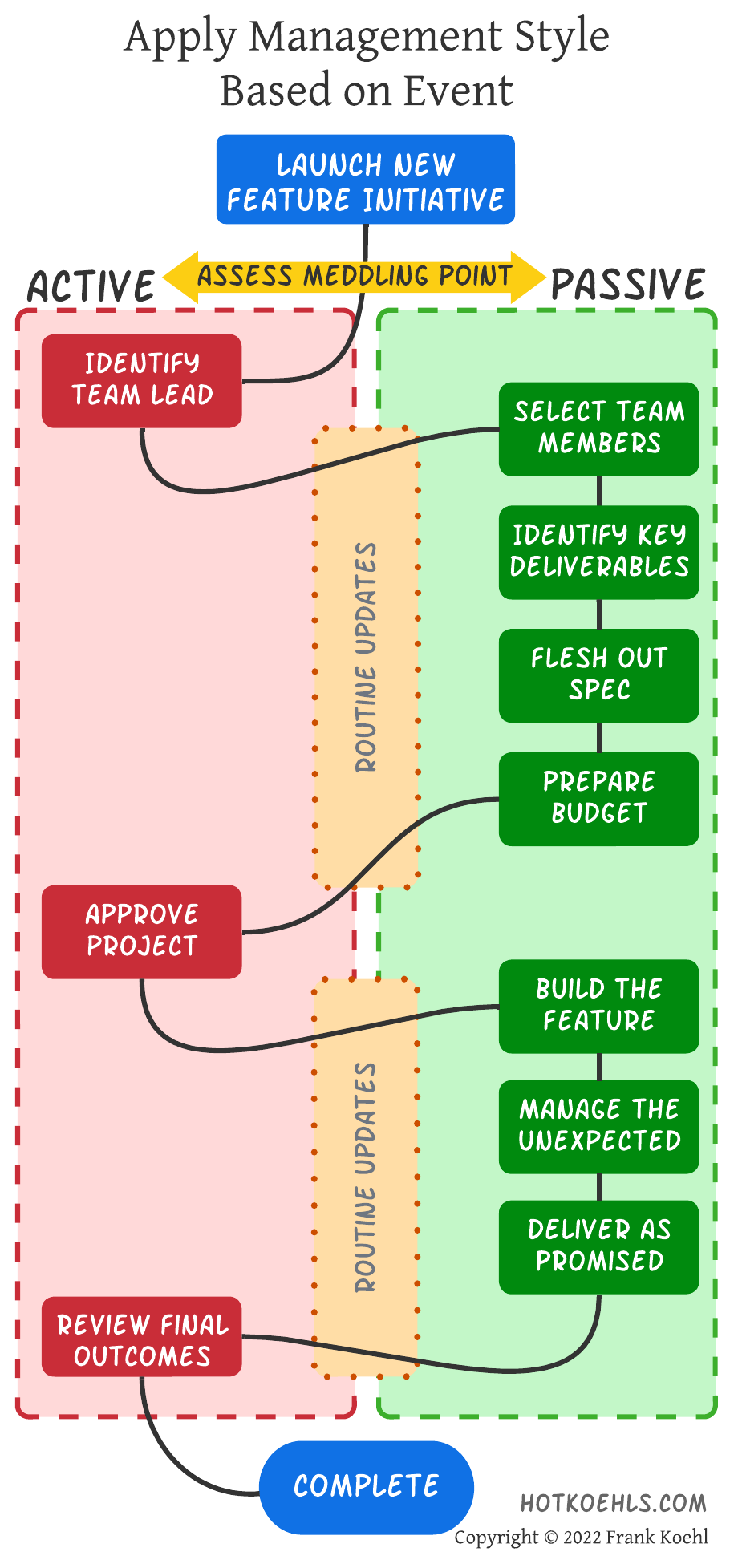
So, Why Manage Less?
At the start of the article we asked, “Why would the managers willingly sign up for this?” What’s in it the for the manager remain hands-off, when active management seems to cover all possibilities?
We now have a bevy of reasons to support this thinking:
- Less work for the manager (everyone, really)
- Incentivize Manager to focus on outcomes, not superfluous details
- Increased employee satisfaction and growth, via agency and ownership of work and the results
- Increased productivity from employees (at the same time as #3!)
- Faster results due to less request-response loops
- Natural check against weak managers, small-minded thinking
All the Things
This type of thinking works at all levels of the organization. My favorite example is annual budget allocations. Lots of companies go through these huge, complicated budget prep exercises each year, where the leaders of each department compile detailed lists of current and upcoming expenditures. There’s usually a fair bit of back and forth with finance teams, the c-suite, and even horse-trading between departments (“You pay for this part of my project, and I’ll help you with yours.”) At the end of this Odyssean effort, the department receives a dollar amount that determines how much they can spend in the next 12 months.
That should be the end of it, right? I gave you a plan, you gave me a number, off we go.
Oh ho, how wrong you are, sir!
Even though the money has been allocated, and the department head granted approval to spend it, many companies will require that they repeat all the same proposal and approval steps when the time comes to actually cut the check. They have the same justification conversation with executives, the same approvals (re)submitted to finance, the same review of workloads and forecasts.
There’s all sort of names and labels applied to this duplicated effort. In my experience they are mostly excuses attempting to paper over a poorly aligned Meddling Point. The executives don’t trust their subordinate teams to make “as good a decision as I would,” so they leave themselves inserted in the process. Many people bemoan “budget season” because it applies (reasonable) oversight in the setup phase, and doesn’t adjust accordingly for execution (yes, you can adjust your Meddling Point over the lifecycle of a project).
Conclusion
If I attempt to boil this article down to a single sentence, it would be:
Every manager should seek to manage by exception, rather than by default.
Handing complete responsibility and freedom for tasks to the people who will perform the work has numerous benefits to the employee, the manager, and the company.
The costs of an “implicit denial” approach are insidious: pain points are well hidden, and often pop up in ways that don’t trace back to the root cause. Think about how many reasons get thrown at the board during a postmortem for a failed project. It’s also just plain easier to trust yourself over others, and so many managers and companies default to delegating tasks without any real agency or authority.
As we illustrated here, even a superficial investigation into the cause and effect of task delegation reveals that the inverse is actually in everyone’s best interest. Implicit approval shifts the responsibility where it belongs, and propagating this mindset out to an entire org can produce amazing results in productivity and satisfaction at all levels.
How to Get Started
Like so many things, the first step is the hardest: get over yourself, trust those around you to carry their weight, and let them share directly in the inevitable victories to follow.
If you delegate tasks, you create followers. if you delegate authority, you create leaders. – Craig Groeschel
comments powered by Disqus

